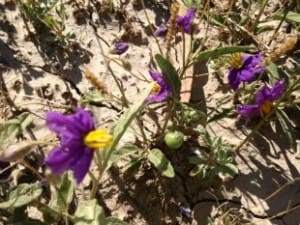
The weed Solanum esuralie — also called Quena, potato bush and wild tomato — has been implicated in cases of Humpy Back in sheep.
FAR west New South Wales sheep producers have been warned to look out for signs of the condition Humpy Back in their flocks after confirmation of cases in the Bourke area.
Department of Primary Industries Veterinary Officer, Dr Charlotte Cavanagh said Humpyback has been confirmed as the cause of Merino sheep ailing while being mustered for shearing earlier this month.
“A sample was collected from suspected sheep and sent to the DPI Elizabeth Macarthur Agricultural Institute (EMAI) for formal analysis,” Dr Cavanagh said.
“Humpyback has been associated with ingestion of Solanum esuralie — also called Quena and potato bush — and also Malvastrum americanum which are generally found 6 to 10 weeks after good rainfall.
“The toxins in these plants cause degenerative changes in the brain and spinal cord,” she said.
“Producers should be aware of the symptoms that include humped back, stress gastroenteritis and fast noisy heart beat.
“There is no cure for Humpyback but producers are advised to allow affected sheep to recover by allowing them to rest and recover, ensuring access to water and shelter.”
Dr Cavanagh said Humpy Back is generally reported in hot weather when full wool Merino sheep are mustered for shearing or during other management practices.
“To avoid Humpy Back, producers should consider rescheduling the muster in cooler weather,” Dr Cavanagh said.
The DPI said it is important that producers report suspected sheep to DPI Veterinary Officer Charlotte Cavanagh on (02)6830 0003, so an accurate diagnosis can be made.
Source: NSW DPI.

I would concur with everything Charlotte says. I spent 30 of my 40 years looking at the condition in my DPI days in south western Queensland, particularly in the Tambo Augathella and Quilpie Downs country; in wet summers mostly in woolly merino sheep (mainly wethers when there were large flocks of them about) mustered for shearing. Those who crutched their sheep in summer time and left “humpy” syndrome sheep on muster alone, saw them survive to be shorn in cooler months. It is a progressively deteriorating spinal cord condition (O’Sullivan, B. et. al.) where sheep lose control of their hind leg gait arching their backs with shortening steps, feet close together and tailing out on muster. Risk increases with every new annual exposure of sheep to the plants mentioned above, so it is rarely seen in yearling sheep. Their identification and culling if possible, is desirable; so they can return some value to the owner before they become a woolly casualty at the next summer shearing muster. The best indicator that producers may have a problem is to look for purple flowered Quena (see picture) which is most often found in table drains along the roadside on deep cracking grey/black clay soils. Numerous lab pen-feeding trials with Quena have failed to conclusively clinch its connection with the disease, despite it always being present with the condition in the field. This could be consistent with a progressive neurological condition. Lloyd.